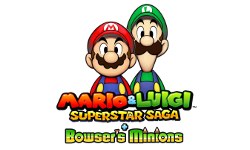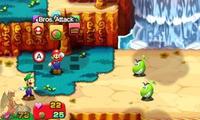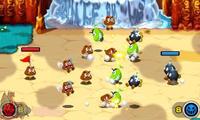|
|

|
PLATFORM
|
3DS
|
BATTLE SYSTEM
|

|
INTERACTION
|

|
ORIGINALITY
|

|
STORY
|

|
MUSIC & SOUND
|

|
VISUALS
|

|
CHALLENGE
|
Adjustable
|
COMPLETION TIME
|
20-40 Hours
|
|
OVERALL

|
+ The fun original game hasn't been ruined
+ Bowser's Minions is entertaining
+ Appealing aesthetics
- Major difficulty jump at the end
- Core game isn't that different
|
Click here for scoring definitions
|
|
|
Strange though it is for me to ponder, the first Mario and Luigi game now qualifies as a nostalgic icon of the past. Since it only exists on the Game Boy Advance and cannot be played using a 3DS, Nintendo has produced a remake. Mario and Luigi: Superstar Saga + Bowser's Minions does not radically revamp the original title, and will not entice anyone who has never been engaged by this particular branch of the Mario series. Something that was an engaging title in 2003 fortunately remains so, and is worth experiencing for those who have never partaken of it before.
The evil Cackletta and her underling Fawful have placed a horrible curse on Princess Peach, causing the Mushroom Kingdom's member of royalty to deliver literally explosive interjections instead of speech. This occasions the Mario brothers to head to Cackletta's home turf of the Beanbean Kingdom seeking a cure for Peach's dynamite text. Cackletta and Fawful have anticipated this danger, and succeed in making a hash of the journey. It's up to the Mario brothers to stomp out this evil plan, a task not made easier by an amnesiac Bowser also wandering the Beanbean Kingdom.
Mario and Luigi games have never tried to craft tense, believable narratives, and this one is no different. Cackletta is evil, Fawful is also evil but with odd syntax that makes him somewhat interesting, Bowser is mostly used as a joke, and the personalities in the Beanbean Kingdom all have a single defining characteristic that sticks out. No one should come to a Mario game looking for tightly-written dialogue and complex characterization though, and Nintendo's entertaining localization ensures that plot moments are never dull. Compared to some of the subsequent Mario and Luigi titles, this one also manages to be fairly concise during its dialogue sequences rather than overwhelming the player with prose.
Inside and outside of battle, Mario and Luigi each have commands associated with the A and B button respectively. At first the trademark jump attack of the brothers is the only one available, but hammers, elemental hands, and Brother abilities that combine the siblings' offensive power are subsequently learned. Properly timed attacks will result in greatly increased damage output, and it is theoretically possible to counterattack or dodge every enemy stratagem in the game. Realistically however, the player is unlikely to possess the fabulous memory and excellent reflexes necessary to never be touched by the foes. Combat essentials in this series haven't changed much over the years, and are as effective here as they've been in all subsequent titles, letting the player usually choose when to engage visible enemies and when to avoid a fight.
 It seems a shame to have to beat up such happy enemies, but oh well.
It seems a shame to have to beat up such happy enemies, but oh well.
|
|
Having originally been developed for the Game Boy Advance, this Mario and Luigi was afforded the chance to use a few more control features which make it much more convenient. The X button can now be used to make the brothers both jump even if they are in a different stance, which is extremely handy. The touch screen displays both a map and markers the player can place for important locations, removing the need to constantly enter the menu for guidance purposes. Also found on the touch screen is a convenient grouping of all the out-of-battle actions that can be performed, removing the need to cycle through all of them using the shoulder buttons. These are the only major changes to the interface, but they're very helpful.
The original Superstar Saga was not exceedingly difficult until its conclusion, something that this version sticks to. A new feature is the Easy mode that can be activated at any time, allowing the brothers to take much less damage and inflict considerably more upon enemies. Easy mode turns most encounters throughout the game into trivial affairs without any real risk of defeat. The final boss remains an exception to this, being quite capable of eviscerating even a prepared player with a wide gamut of attacks that just keep coming.
Bowser's Minions has nothing to do with the chattering yellow flunkies of Gru, and everything to do with getting to play as some of the longtime villains of the Mario world. When Bowser is unceremoniously deposited into Beanbean Kingdom thanks to Fawful's attack upon his midair castle, plenty of other nasties from the Mushroom Kingdom also wind up in unfamiliar surroundings. One Goomba decides to get out of this place while finding and saving Bowser from whatever travails he may be encountering. Captain Goomba is soon joined by a Shy Guy, a Boo Buddy and a Koopa Troopa, all of which take turns leading a growing assemblage of Bowser's soldiers to triumph over the forces that Fawful has placed in their way.
 It's a good thing that flag doesn't make Captain Goomba top-heavy.
It's a good thing that flag doesn't make Captain Goomba top-heavy.
|
|
Baddies are beaten down here via an RTS using the Mario universe. Aside from putting the eight members of the team together, the player's only input is to use special abilities accessible by the current captain, and to add the necessary motion or button press for critical strikes. Otherwise the team will fight on its own against adversaries. A great variety of troops is available to help preparitions for battle, though since the player is required to go through multiple fights in succession there is often no ideal troop contingent to take the field. Bowser's Minions is not a complex RTS by any means, but it is entertaining to play and supplies a sizable adjunct to the main game.
While the 2003 edition of this game had very good aesthetics for the Game Boy Advance, the visual overhaul performed for 3DS is impressive. Sprites are much more detailed now, which helps a bit when enemy animations make it more obvious what attack is about to be performed. The current incarnation of the game may not strain the hardware, but it looks resplendent. Yoko Shimomura's score benefits from better sound than the GBA could perform, and the impressive array of compositions is augmented by a few new ones that are equally enticing. Sound effects range from those that originated in the 1980s to nonsensical-but-amusing vocal snippets from the many personalities around the Beanbean kingdom.
There's no strong reason to go back and play the original version of Mario and Luigi with this one around, and I had about as much fun now as I did in 2003. The interface amenities are certainly a nice touch, Bowser's Minions is a very respectable addition, and having a beefed-up role for the Koopalings as minions is something I personally delighted in experiencing. It's certainly not going to convert anyone who never cared for this style of game, but what's here is a fun romp.
Review Archives
|









